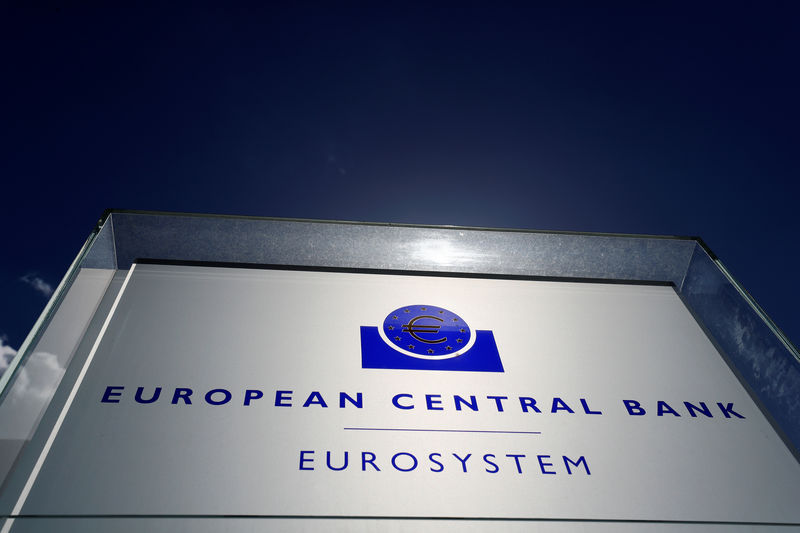By Dhara Ranasinghe
LONDON (Reuters) - Cheap bank loans, a form of stimulus first launched by the ECB during the global financial crisis, look set to make a comeback in coming months and investors anticipate shorter term loans with a variable rate to allow the central bank flexibility.
It's just two months since the European Central Bank wrapped up its 2.6 trillion euro ($2.9 trillion) bond-buying scheme, but with euro zone growth at four-year lows and other global central banks already backtracking on policy tightening, bond market expectations of ECB action are on the rise.
That's expected to take the shape of a loan package for banks -- known as Long Term Refinancing Operations (LTROs) or the more targeted TLTROs. Details could come in March or June at ECB meetings that would coincide with updates of the central bank's economic forecasts.
LTROs or TLTROs -- which ECB sources say are a priority over other measures -- should lower funding costs for businesses and households and offset the effect of negative interest rates on banks, investors argue.
They should also boost prices -- the last TLTRO round from 2016 lifted inflation by 0.3 percent over two years, Pictet Wealth Management estimates.
However, the new package is unlikely to be as favorable as in the past because the economy is in better shape compared with the 2011-12 debt crisis or even 2016 when the ECB deployed a combination of TLTROs, rate cuts and increased asset buys to fight deflation.
(GRAPHIC: ECB mulls fresh cheap loan package to boost economy - https://tmsnrt.rs/2BppeS2)
So what will the program look like?
The 2016 TLTROs allowed banks to lock in lending rates as low as the ECB's new lower deposit rate of minus 0.40 percent. The loans had a four-year maturity.
This time investors expect the ECB to opt for a shorter term, say two years.
"I don't think they (the ECB) need to go as big as they did in 2016 - when there was a real deflation risk," said Francois Savary, CIO at Prime Partners, who also anticipates fixed rate loans.
"But clearly there is room to do something because the financial system in Europe has not yet fully recovered."
One idea floated is to make TLTROs a permanent facility with a floating interest rate that tracks the ECB's Main Refinancing Operation, one source told Reuters in December.
A variable rate would give the ECB leeway to raise rates moving forward, strategists said.
"Unless the growth momentum deteriorates further, new LTROs should have a shorter maturity, say two years and a variable rate, leaving the door open to rate hikes over the next few years," said Pictet Wealth Management strategist Frederik Ducrozet.
RATE GUIDANCE
Interest in new TLTROs will be high also because investors reckon it will offer clues on the ECB's rate outlook. Despite the stuttering economy, some policymakers are said to be reluctant to alter their current guidance for an end-2019 rate rise because ECB chief Mario Draghi's term ends in October.
Shweta Singh, senior economist at TS Lombard, said the design of the TLTRO program would have much bearing on the rate path.
"If they decide to go for a fixed interest rate on the TLTRO loans then that does suggest the ECB expects policy to remain low for a longer period," she said.
As for timing, the ECB has an incentive to act by June as it will want to avoid liquidity shortages that could arise from mid-2020 as previous TLTROs start to mature.
The first maturities would start to impact banks' funding costs already in mid-2019, since banks need to have funding with a maturity of at least one year to meet regulatory requirements.
Under the Net Stable Funding Ratio requirement, euro zone banks must have a certain amount of multi-year funding in place.
Italy and Spain, where the take-up of these loans was highest, are considered most vulnerable to this kind of cliff-edge scenario. So it is unsurprising that government bonds and bank stocks in these countries tend to rally whenever TLTRO speculation arises.
(For an interactive version of the below chart, click here https://tmsnrt.rs/2BleaoL)
The ECB also has another option -- delaying the TLTRO payments due in June 2020 by a year, said Hetal Mehta, Legal & General Investment Management's senior European economist.
"That would be the path of least resistance. To come up with a new scheme and new criteria might be more difficult but the ECB have a template. They've done it a couple of times now," Mehta said.
